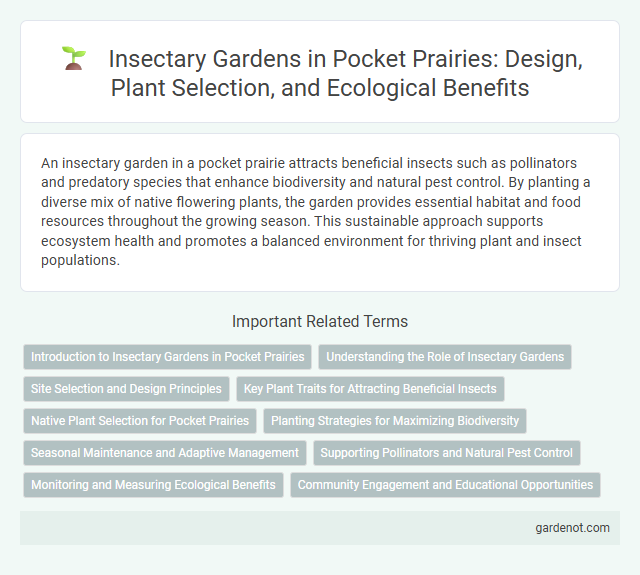An insectary garden in a pocket prairie attracts beneficial insects such as pollinators and predatory species that enhance biodiversity and natural pest control. By planting a diverse mix of native flowering plants, the garden provides essential habitat and food resources throughout the growing season. This sustainable approach supports ecosystem health and promotes a balanced environment for thriving plant and insect populations.
Introduction to Insectary Gardens in Pocket Prairies
Insectary gardens within pocket prairies create habitats that support beneficial insects like pollinators and natural pest predators. These gardens are designed with native flowering plants that bloom at varying times, providing continuous nectar and pollen resources crucial for insect survival. Integrating insectary plants enhances biodiversity and promotes natural pest control, making pocket prairies vital for sustainable urban ecological networks.
Understanding the Role of Insectary Gardens
Insectary gardens play a crucial role in supporting biodiversity by attracting beneficial insects such as pollinators and natural pest predators. These gardens provide essential habitats and nectar sources, enhancing the overall health and productivity of pocket prairies. Incorporating native flowering plants in insectary gardens promotes ecological balance and reduces the need for chemical pest control.
Site Selection and Design Principles
Site selection for an insectary garden within a pocket prairie prioritizes areas with ample sunlight exposure, well-drained soil, and proximity to native plant species to maximize pollinator attraction and biodiversity. Design principles emphasize plant diversity with a mix of native flowering plants that bloom sequentially, providing continuous nectar and pollen sources throughout the growing season. Incorporating structural variety, such as varying plant heights and microhabitats, enhances habitat complexity and supports a wide range of beneficial insects.
Key Plant Traits for Attracting Beneficial Insects
Key plant traits for attracting beneficial insects in an insectary garden include nectar-rich flowers, diverse bloom periods, and native plant species that support local pollinators and predators. Plants with shallow, open flowers facilitate easy access to nectar and pollen, while structural diversity provides shelter and breeding sites. Incorporating aromatic herbs and plants with extrafloral nectaries enhances insect attraction and habitat sustainability.
Native Plant Selection for Pocket Prairies
Native plant selection in pocket prairie insectary gardens enhances biodiversity by providing habitat and food sources tailored to local insect populations. Choosing indigenous flowering species such as goldenrod, coneflowers, and milkweed attracts pollinators like bees, butterflies, and beneficial predatory insects that naturally control pests. Incorporating diverse native plants ensures year-round bloom cycles, supporting insect lifecycles and promoting ecological balance within urban or small-scale pocket prairie ecosystems.
Planting Strategies for Maximizing Biodiversity
Plant diverse native flowering plants with staggered bloom times to attract and support a wide range of pollinators and beneficial insects throughout the growing season. Incorporate structural variety by including herbs, grasses, and shrubs to create multiple habitat layers that cater to different insect species. Use companion planting to enhance pest control and promote symbiotic relationships, increasing overall ecosystem resilience in the pocket prairie.
Seasonal Maintenance and Adaptive Management
Seasonal maintenance of an insectary garden in a pocket prairie involves regular pruning, mulching, and monitoring for pest populations to ensure optimal habitat conditions for beneficial insects. Adaptive management practices include adjusting plant species composition and irrigation schedules based on observed insect activity and weather patterns to promote biodiversity. Consistent evaluation and modification enhance pollinator support and natural pest control throughout the growing seasons.
Supporting Pollinators and Natural Pest Control
Insectary gardens in pocket prairies provide essential habitats that support diverse pollinators such as bees, butterflies, and hoverflies, enhancing plant reproduction and biodiversity. These gardens attract beneficial predatory insects like ladybugs and parasitic wasps that naturally suppress pest populations, reducing the need for chemical pesticides. Incorporating native flowering plants rich in nectar and pollen ensures continual food sources, promoting a balanced ecosystem for sustainable pest control and pollination services.
Monitoring and Measuring Ecological Benefits
Monitoring and measuring ecological benefits in a pocket prairie insectary garden involves tracking pollinator diversity, abundance, and habitat health over time. Utilizing tools such as insect traps, visual surveys, and plant bloom records helps quantify interactions between native plants and beneficial insects. Data-driven assessments support adaptive management strategies to enhance ecosystem services like pest control, pollination, and biodiversity conservation.
Community Engagement and Educational Opportunities
Insectary gardens within pocket prairies serve as dynamic platforms for community engagement by attracting diverse pollinators and beneficial insects, fostering environmental stewardship among local residents. These gardens offer educational opportunities through hands-on learning experiences, workshops, and citizen science projects that teach about native plant species, insect ecology, and sustainable gardening practices. By involving schools, community groups, and volunteers, insectary gardens create interactive spaces promoting biodiversity awareness and support urban conservation efforts.
Insectary garden Infographic

 gardenot.com
gardenot.com